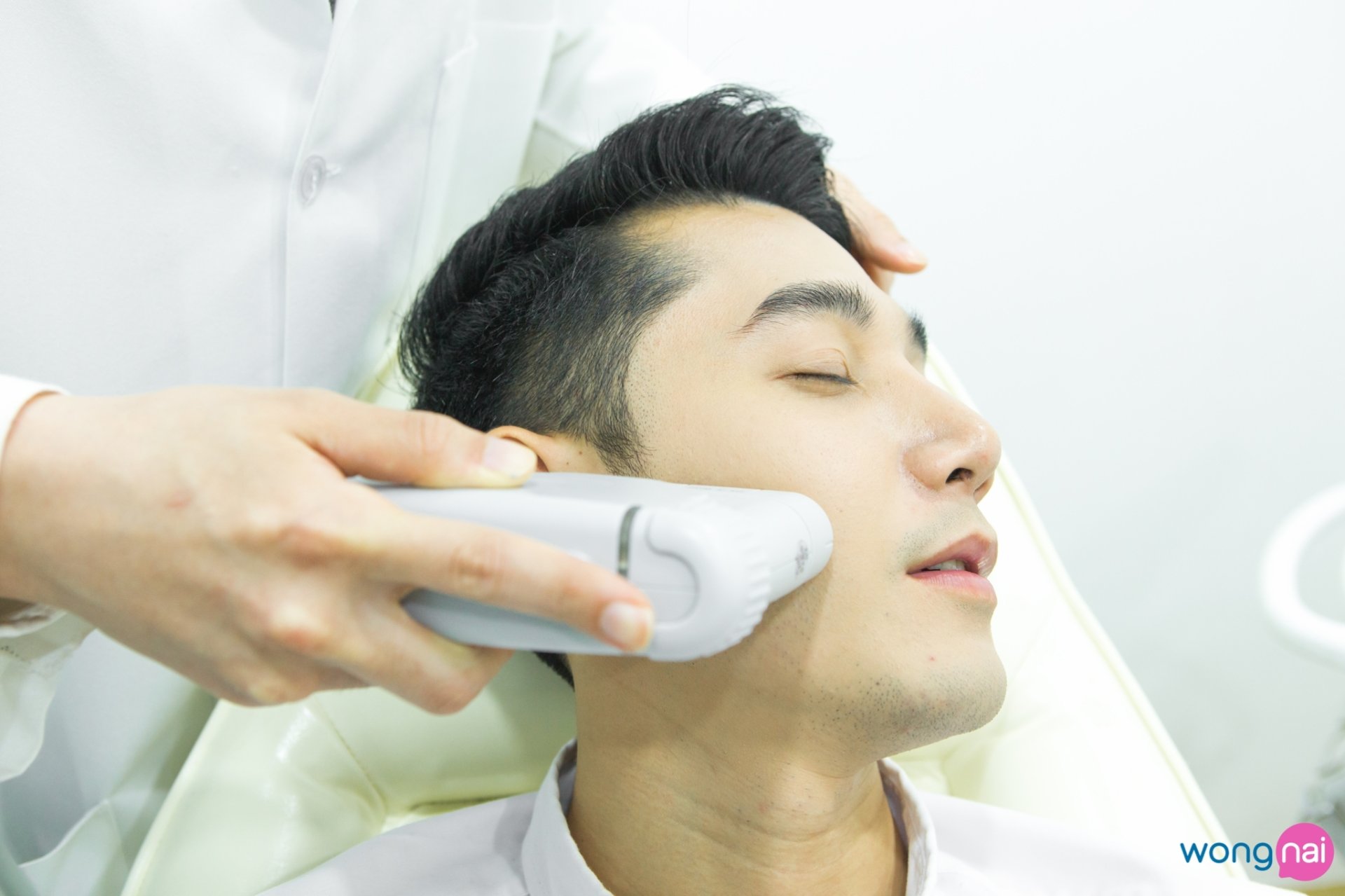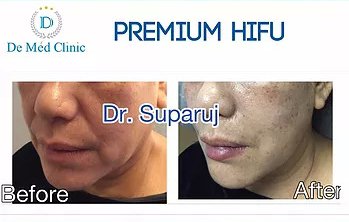Last updated: 6 พ.ค. 2562 | 5820 จำนวนผู้เข้าชม |

| Premium HIFU Therapy นวัตกรรมยกกระชับใบหน้า ช่วยยกกระชับผิวถึงชั้นลึก หน้ากระชับ เรียว สวย ด้วยเทคนิคพิเศษของเดอเมชคลินิก ทำให้เห็นผลชัดเจน - ไม่เจ็บ ไม่ต้องพักฟื้น หลังทำแต่งหน้าได้เลย - ยกกระชับ ปรับหน้าเรียว เห็นผลหลังทำในทันที - แก้ปัญหาผิวหย่อนคล้อย ขาดความกระชับ - ช่วยยกคิ้วในผู้ที่มีปัญหาแนวคิ้วตก - ช่วยให้กรอบหน้าชัดใบหน้าได้สัดส่วนที่ดี - แก้ปัญหาหน้าใหญ่ เนื่องจากไขมันสะสมบริเวณแก้ม - ลดคาง 2 ชั้น และมีไขมันสะสมส่วนเกิน - แก้ปัญหาผิวหมองคล้ำ ขาดความกระจ่างใส |  | ||
 |  | ||
 | |||
| พี่ Teddy Eiffel ให้เกียรติมาดูแล ผิวหน้า ยกกระชับลดริ้วรอย ด้วย Premium HIFU ที่ de med clinic ครับ | |||
|
| ||
| น้องอาร์มสุกวิณ Arm Sukavin Kaewpikul มาเสริมหล่อด้วยโปรแกรม Premium HIFU ที่เดอเมชคลินิกให้หล่อเป๊ะ เตรียมพร้อมละครเรื่องใหม่ครับที่จะ go inter ไปเป็นพระเอกที่ต่างประเทศครับ | |||
High-intensity focused ultrasound (HIFU) for Face Lift
What is HIFU?
High-intensity focused ultrasound (HIFU) is a relatively new cosmetic treatment for skin tightening that some consider a noninvasive and painless replacement for face lifts. It uses ultrasound energy to encourage the production of collagen, which results in firmer skin.
HIFU uses focused ultrasound energy to target the layers of skin just below the surface. The ultrasound energy causes the tissue to heat up rapidly.
Once the cells in the targeted area reach a certain temperature, they experience cellular damage. While this may seem counterintuitive, the damage actually stimulates the cells to produce more collagen — a protein that provides structure to the skin.
The increase in collagen results in tighter, firmer skin with fewer wrinkles. Since the high-frequency ultrasound beams are focused on a specific tissue site below the skin’s surface, there’s no damage to the upper layers of the skin and adjacent issue.
HIFU may not be appropriate for everyone. In general, the procedure works best on people older than 30 with mild-to-moderate skin laxity.
People with photodamaged skin or a high degree of loose skin may need several treatments before seeing results.
Older people with more extensive photo-aging, severe skin laxity, or very saggy skin on the neck aren’t good candidates and may need surgery.
HIFU isn’t recommended for people with infections and open skin lesions at the target area, severe or cystic acne, and metallic implants in the treatment area.
Benefits of high-intensity focused ultrasound
According to the American Society for Aesthetic Plastic Surgery (ASAPS), HIFU and other nonsurgical alternatives to facelifts have seen a major increase in popularity over the last few years. The total number of procedures performed has increased 64.8 percent between 2012 and 2017.
HIFU has many aesthetic benefits, including:
· wrinkle reduction
· tightening sagging skin on the neck (sometimes called turkey neck)
· lifting the cheeks, eyebrows, and eyelids
· enhancing jawline definition
· tightening of the décolletage
· smoothing the skin
HIFU vs. facelift
While HIFU carries far fewer risks and costs than a surgical face lift, results may not last as long and repeated procedures may be needed. Here’s a summary of the major differences between each procedure:
What does HIFU feel like?
You may experience slight discomfort during an HIFU procedure. Some people describe it as tiny electric pulses or a light prickly sensation.
If you’re worried about pain, your doctor may suggest taking acetaminophen (Tylenol) or a nonsteroidal anti-inflammatory drug (NSAID), such as ibuprofen (Advil), prior to treatment.
Immediately after the treatment, you may experience mild redness or swelling, which will gradually recede over the next few hours.
HIFU for face procedure
There’s no special preparation needed before having an HIFU procedure. You should remove all makeup and skin care products from the target area before treatment.
Here’s what to expect at your appointment:
· A physician or technician first cleans the target area.
· They may apply a topical anesthetic cream before starting.
· The physician or technician then applies an ultrasound gel.
· The HIFU device is placed against the skin.
· Using an ultrasound viewer, the physician or technician adjusts the device to the right setting.
· Ultrasound energy is then delivered to the target area in short pulses for roughly 30 to 90 minutes.
· The device is removed.
· If additional treatments are needed, you will schedule the next treatment.